MPM 581: Project Funding Sources and Financial Management Analysis
VerifiedAdded on 2023/03/20
|10
|2635
|76
Homework Assignment
AI Summary
This assignment, prepared for MPM 581, delves into the intricacies of project financing and financial management. It begins by defining project financing and exploring various funding sources, including loans, grants, and equity, along with their implications on project success. The assignment then examines the benefits and risks associated with joint ventures in the context of long-term business plans and project funding. Furthermore, it outlines the detailed processes involved in project financial management, such as planning, control, administration, and record-keeping, with references to PMBOK. Key concepts like resource planning, cost estimating, cost budgeting, and cost control are defined and illustrated with examples. Finally, the assignment identifies cost control as a significant challenge in project cost and finance management, providing a rationale for its importance. The document offers a comprehensive overview of project finance, covering critical aspects of funding, management, and risk assessment.
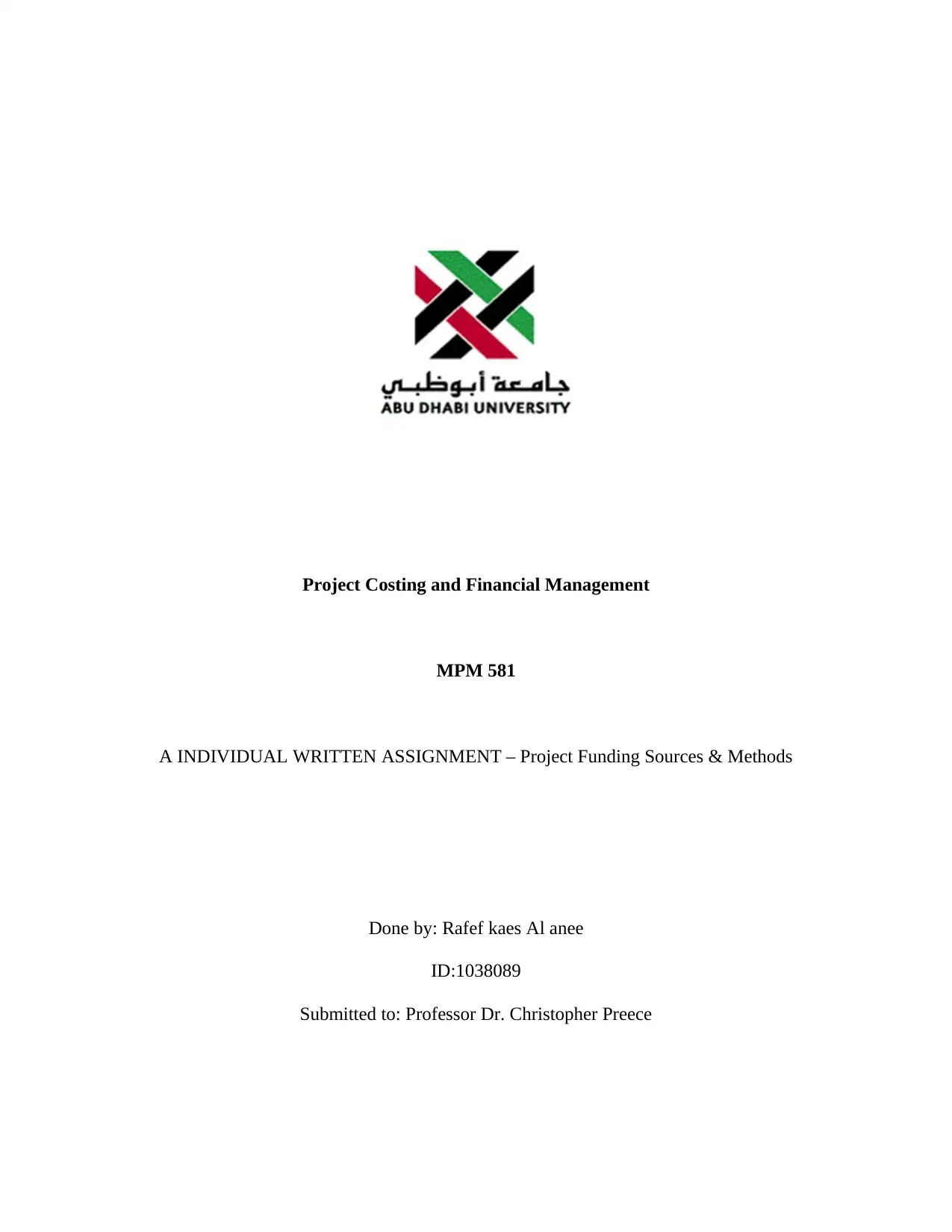
Project Costing and Financial Management
MPM 581
A INDIVIDUAL WRITTEN ASSIGNMENT – Project Funding Sources & Methods
Done by: Rafef kaes Al anee
ID:1038089
Submitted to: Professor Dr. Christopher Preece
MPM 581
A INDIVIDUAL WRITTEN ASSIGNMENT – Project Funding Sources & Methods
Done by: Rafef kaes Al anee
ID:1038089
Submitted to: Professor Dr. Christopher Preece
Paraphrase This Document
Need a fresh take? Get an instant paraphrase of this document with our AI Paraphraser
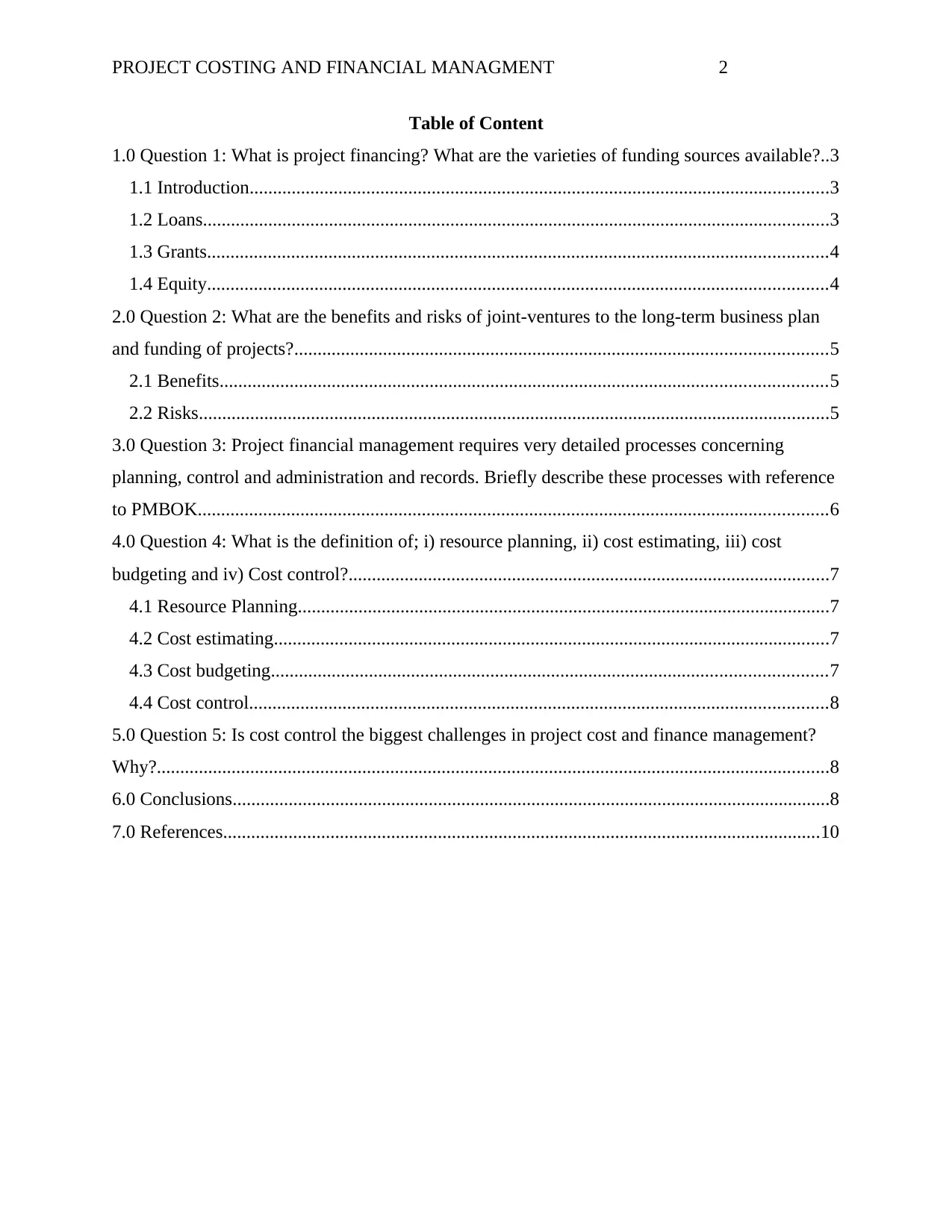
PROJECT COSTING AND FINANCIAL MANAGMENT 2
Table of Content
1.0 Question 1: What is project financing? What are the varieties of funding sources available?..3
1.1 Introduction............................................................................................................................3
1.2 Loans......................................................................................................................................3
1.3 Grants.....................................................................................................................................4
1.4 Equity.....................................................................................................................................4
2.0 Question 2: What are the benefits and risks of joint-ventures to the long-term business plan
and funding of projects?..................................................................................................................5
2.1 Benefits..................................................................................................................................5
2.2 Risks.......................................................................................................................................5
3.0 Question 3: Project financial management requires very detailed processes concerning
planning, control and administration and records. Briefly describe these processes with reference
to PMBOK.......................................................................................................................................6
4.0 Question 4: What is the definition of; i) resource planning, ii) cost estimating, iii) cost
budgeting and iv) Cost control?.......................................................................................................7
4.1 Resource Planning..................................................................................................................7
4.2 Cost estimating.......................................................................................................................7
4.3 Cost budgeting.......................................................................................................................7
4.4 Cost control............................................................................................................................8
5.0 Question 5: Is cost control the biggest challenges in project cost and finance management?
Why?................................................................................................................................................8
6.0 Conclusions................................................................................................................................8
7.0 References................................................................................................................................10
Table of Content
1.0 Question 1: What is project financing? What are the varieties of funding sources available?..3
1.1 Introduction............................................................................................................................3
1.2 Loans......................................................................................................................................3
1.3 Grants.....................................................................................................................................4
1.4 Equity.....................................................................................................................................4
2.0 Question 2: What are the benefits and risks of joint-ventures to the long-term business plan
and funding of projects?..................................................................................................................5
2.1 Benefits..................................................................................................................................5
2.2 Risks.......................................................................................................................................5
3.0 Question 3: Project financial management requires very detailed processes concerning
planning, control and administration and records. Briefly describe these processes with reference
to PMBOK.......................................................................................................................................6
4.0 Question 4: What is the definition of; i) resource planning, ii) cost estimating, iii) cost
budgeting and iv) Cost control?.......................................................................................................7
4.1 Resource Planning..................................................................................................................7
4.2 Cost estimating.......................................................................................................................7
4.3 Cost budgeting.......................................................................................................................7
4.4 Cost control............................................................................................................................8
5.0 Question 5: Is cost control the biggest challenges in project cost and finance management?
Why?................................................................................................................................................8
6.0 Conclusions................................................................................................................................8
7.0 References................................................................................................................................10
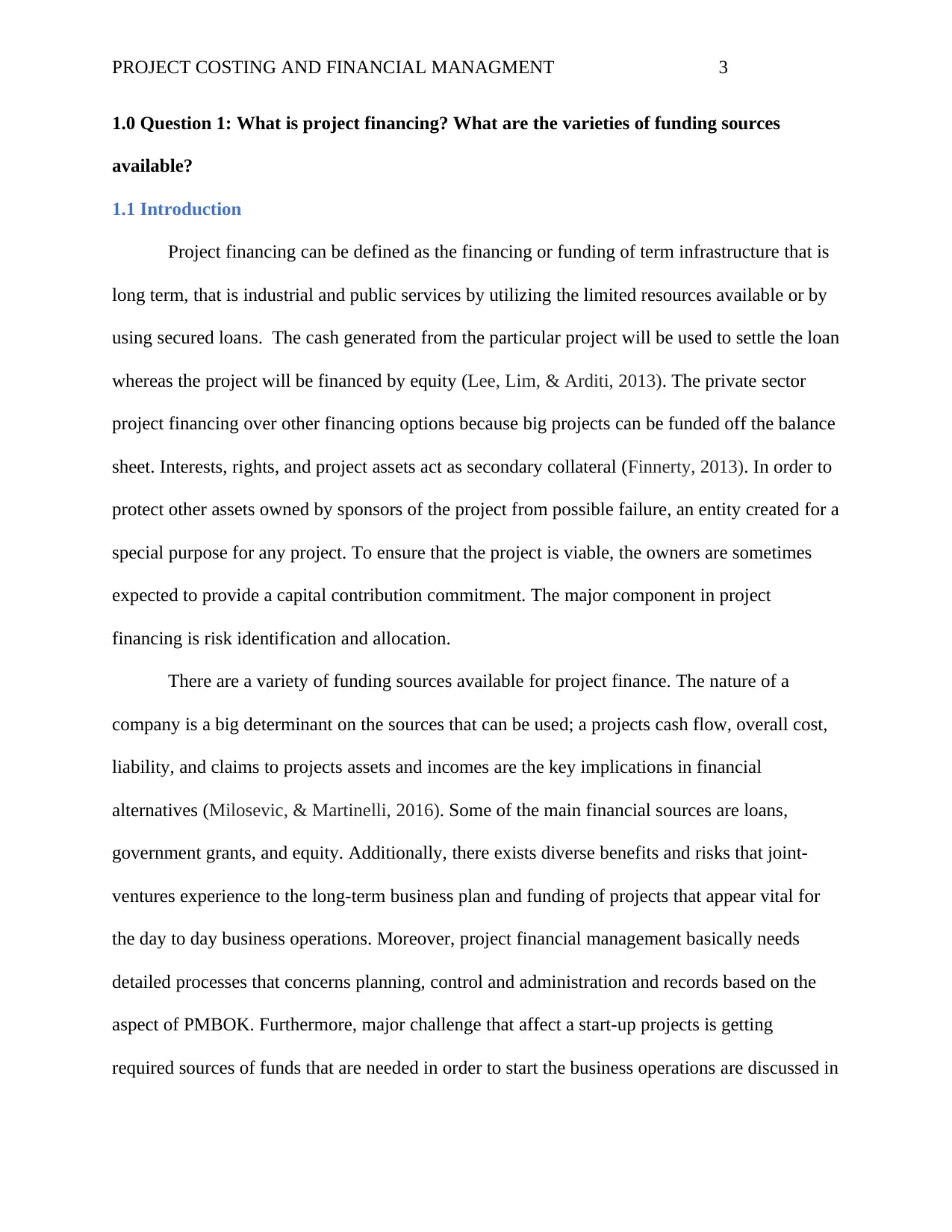
PROJECT COSTING AND FINANCIAL MANAGMENT 3
1.0 Question 1: What is project financing? What are the varieties of funding sources
available?
1.1 Introduction
Project financing can be defined as the financing or funding of term infrastructure that is
long term, that is industrial and public services by utilizing the limited resources available or by
using secured loans. The cash generated from the particular project will be used to settle the loan
whereas the project will be financed by equity (Lee, Lim, & Arditi, 2013). The private sector
project financing over other financing options because big projects can be funded off the balance
sheet. Interests, rights, and project assets act as secondary collateral (Finnerty, 2013). In order to
protect other assets owned by sponsors of the project from possible failure, an entity created for a
special purpose for any project. To ensure that the project is viable, the owners are sometimes
expected to provide a capital contribution commitment. The major component in project
financing is risk identification and allocation.
There are a variety of funding sources available for project finance. The nature of a
company is a big determinant on the sources that can be used; a projects cash flow, overall cost,
liability, and claims to projects assets and incomes are the key implications in financial
alternatives (Milosevic, & Martinelli, 2016). Some of the main financial sources are loans,
government grants, and equity. Additionally, there exists diverse benefits and risks that joint-
ventures experience to the long-term business plan and funding of projects that appear vital for
the day to day business operations. Moreover, project financial management basically needs
detailed processes that concerns planning, control and administration and records based on the
aspect of PMBOK. Furthermore, major challenge that affect a start-up projects is getting
required sources of funds that are needed in order to start the business operations are discussed in
1.0 Question 1: What is project financing? What are the varieties of funding sources
available?
1.1 Introduction
Project financing can be defined as the financing or funding of term infrastructure that is
long term, that is industrial and public services by utilizing the limited resources available or by
using secured loans. The cash generated from the particular project will be used to settle the loan
whereas the project will be financed by equity (Lee, Lim, & Arditi, 2013). The private sector
project financing over other financing options because big projects can be funded off the balance
sheet. Interests, rights, and project assets act as secondary collateral (Finnerty, 2013). In order to
protect other assets owned by sponsors of the project from possible failure, an entity created for a
special purpose for any project. To ensure that the project is viable, the owners are sometimes
expected to provide a capital contribution commitment. The major component in project
financing is risk identification and allocation.
There are a variety of funding sources available for project finance. The nature of a
company is a big determinant on the sources that can be used; a projects cash flow, overall cost,
liability, and claims to projects assets and incomes are the key implications in financial
alternatives (Milosevic, & Martinelli, 2016). Some of the main financial sources are loans,
government grants, and equity. Additionally, there exists diverse benefits and risks that joint-
ventures experience to the long-term business plan and funding of projects that appear vital for
the day to day business operations. Moreover, project financial management basically needs
detailed processes that concerns planning, control and administration and records based on the
aspect of PMBOK. Furthermore, major challenge that affect a start-up projects is getting
required sources of funds that are needed in order to start the business operations are discussed in
⊘ This is a preview!⊘
Do you want full access?
Subscribe today to unlock all pages.

Trusted by 1+ million students worldwide
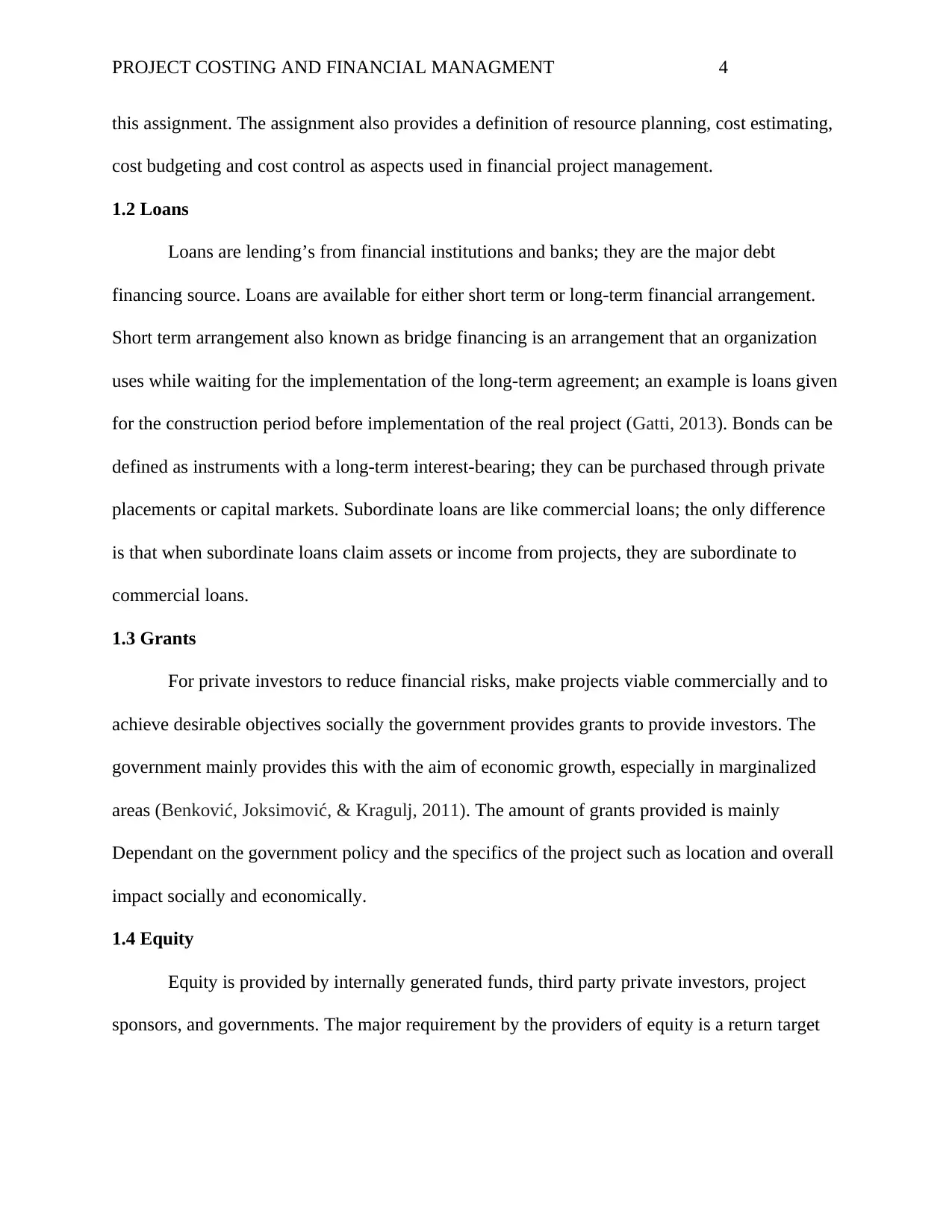
PROJECT COSTING AND FINANCIAL MANAGMENT 4
this assignment. The assignment also provides a definition of resource planning, cost estimating,
cost budgeting and cost control as aspects used in financial project management.
1.2 Loans
Loans are lending’s from financial institutions and banks; they are the major debt
financing source. Loans are available for either short term or long-term financial arrangement.
Short term arrangement also known as bridge financing is an arrangement that an organization
uses while waiting for the implementation of the long-term agreement; an example is loans given
for the construction period before implementation of the real project (Gatti, 2013). Bonds can be
defined as instruments with a long-term interest-bearing; they can be purchased through private
placements or capital markets. Subordinate loans are like commercial loans; the only difference
is that when subordinate loans claim assets or income from projects, they are subordinate to
commercial loans.
1.3 Grants
For private investors to reduce financial risks, make projects viable commercially and to
achieve desirable objectives socially the government provides grants to provide investors. The
government mainly provides this with the aim of economic growth, especially in marginalized
areas (Benković, Joksimović, & Kragulj, 2011). The amount of grants provided is mainly
Dependant on the government policy and the specifics of the project such as location and overall
impact socially and economically.
1.4 Equity
Equity is provided by internally generated funds, third party private investors, project
sponsors, and governments. The major requirement by the providers of equity is a return target
this assignment. The assignment also provides a definition of resource planning, cost estimating,
cost budgeting and cost control as aspects used in financial project management.
1.2 Loans
Loans are lending’s from financial institutions and banks; they are the major debt
financing source. Loans are available for either short term or long-term financial arrangement.
Short term arrangement also known as bridge financing is an arrangement that an organization
uses while waiting for the implementation of the long-term agreement; an example is loans given
for the construction period before implementation of the real project (Gatti, 2013). Bonds can be
defined as instruments with a long-term interest-bearing; they can be purchased through private
placements or capital markets. Subordinate loans are like commercial loans; the only difference
is that when subordinate loans claim assets or income from projects, they are subordinate to
commercial loans.
1.3 Grants
For private investors to reduce financial risks, make projects viable commercially and to
achieve desirable objectives socially the government provides grants to provide investors. The
government mainly provides this with the aim of economic growth, especially in marginalized
areas (Benković, Joksimović, & Kragulj, 2011). The amount of grants provided is mainly
Dependant on the government policy and the specifics of the project such as location and overall
impact socially and economically.
1.4 Equity
Equity is provided by internally generated funds, third party private investors, project
sponsors, and governments. The major requirement by the providers of equity is a return target
Paraphrase This Document
Need a fresh take? Get an instant paraphrase of this document with our AI Paraphraser
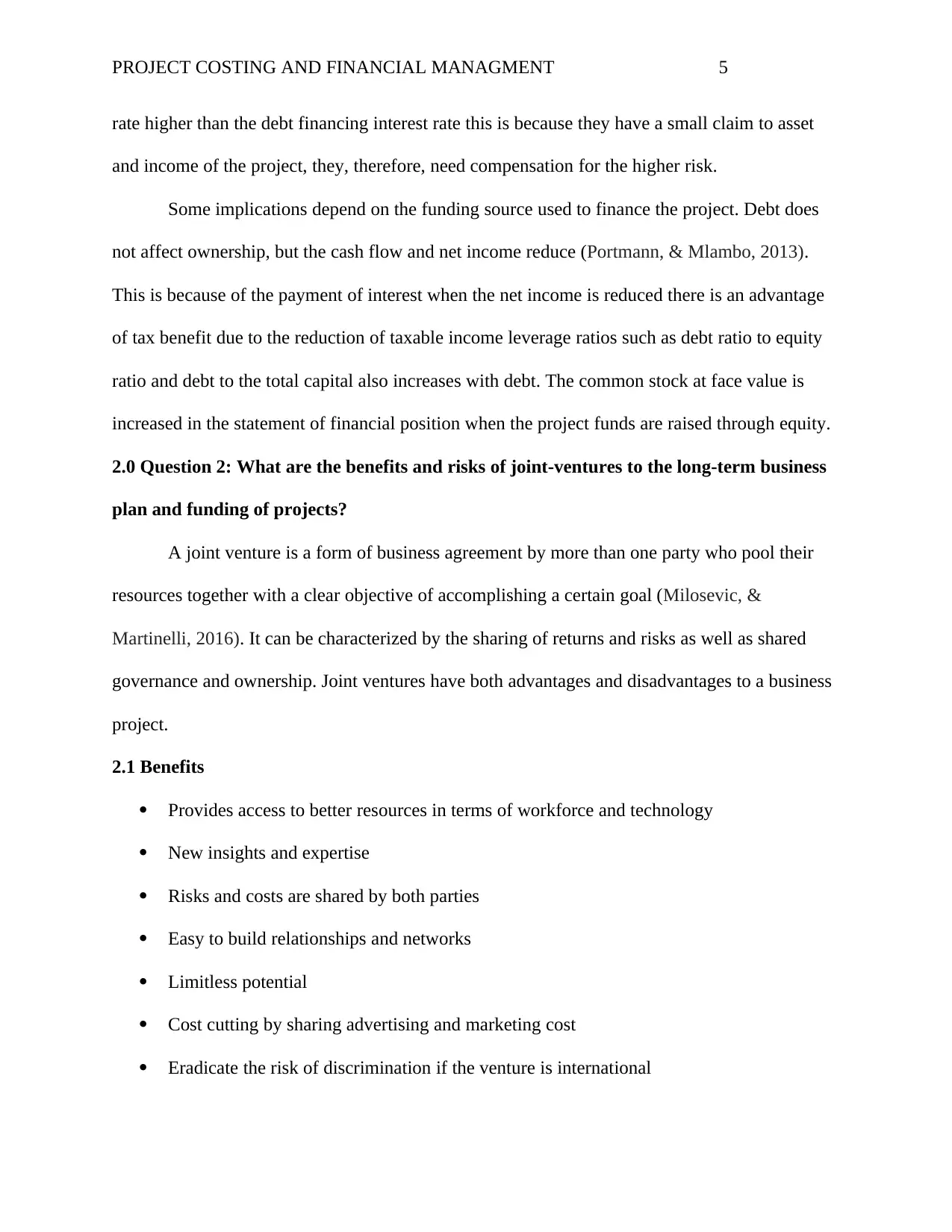
PROJECT COSTING AND FINANCIAL MANAGMENT 5
rate higher than the debt financing interest rate this is because they have a small claim to asset
and income of the project, they, therefore, need compensation for the higher risk.
Some implications depend on the funding source used to finance the project. Debt does
not affect ownership, but the cash flow and net income reduce (Portmann, & Mlambo, 2013).
This is because of the payment of interest when the net income is reduced there is an advantage
of tax benefit due to the reduction of taxable income leverage ratios such as debt ratio to equity
ratio and debt to the total capital also increases with debt. The common stock at face value is
increased in the statement of financial position when the project funds are raised through equity.
2.0 Question 2: What are the benefits and risks of joint-ventures to the long-term business
plan and funding of projects?
A joint venture is a form of business agreement by more than one party who pool their
resources together with a clear objective of accomplishing a certain goal (Milosevic, &
Martinelli, 2016). It can be characterized by the sharing of returns and risks as well as shared
governance and ownership. Joint ventures have both advantages and disadvantages to a business
project.
2.1 Benefits
Provides access to better resources in terms of workforce and technology
New insights and expertise
Risks and costs are shared by both parties
Easy to build relationships and networks
Limitless potential
Cost cutting by sharing advertising and marketing cost
Eradicate the risk of discrimination if the venture is international
rate higher than the debt financing interest rate this is because they have a small claim to asset
and income of the project, they, therefore, need compensation for the higher risk.
Some implications depend on the funding source used to finance the project. Debt does
not affect ownership, but the cash flow and net income reduce (Portmann, & Mlambo, 2013).
This is because of the payment of interest when the net income is reduced there is an advantage
of tax benefit due to the reduction of taxable income leverage ratios such as debt ratio to equity
ratio and debt to the total capital also increases with debt. The common stock at face value is
increased in the statement of financial position when the project funds are raised through equity.
2.0 Question 2: What are the benefits and risks of joint-ventures to the long-term business
plan and funding of projects?
A joint venture is a form of business agreement by more than one party who pool their
resources together with a clear objective of accomplishing a certain goal (Milosevic, &
Martinelli, 2016). It can be characterized by the sharing of returns and risks as well as shared
governance and ownership. Joint ventures have both advantages and disadvantages to a business
project.
2.1 Benefits
Provides access to better resources in terms of workforce and technology
New insights and expertise
Risks and costs are shared by both parties
Easy to build relationships and networks
Limitless potential
Cost cutting by sharing advertising and marketing cost
Eradicate the risk of discrimination if the venture is international
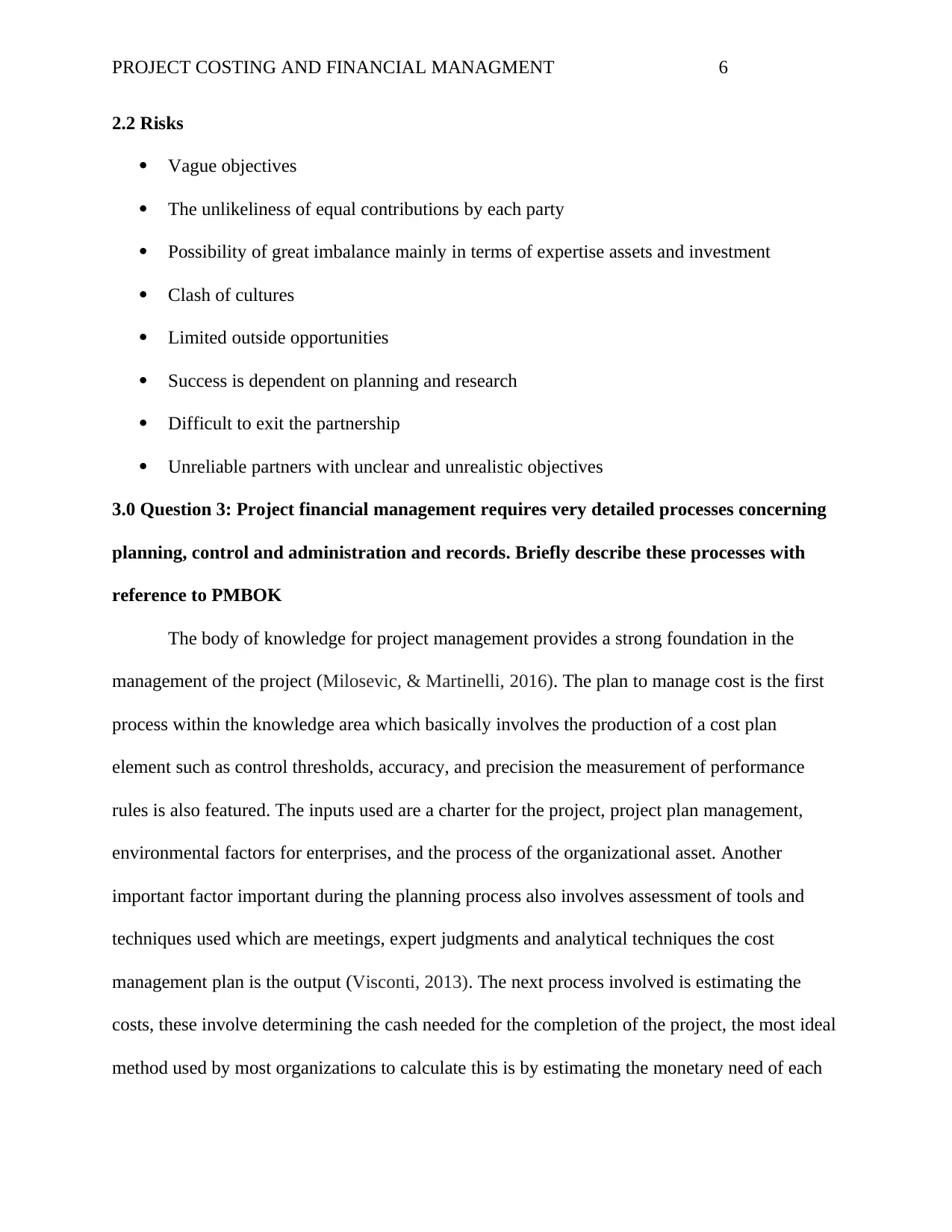
PROJECT COSTING AND FINANCIAL MANAGMENT 6
2.2 Risks
Vague objectives
The unlikeliness of equal contributions by each party
Possibility of great imbalance mainly in terms of expertise assets and investment
Clash of cultures
Limited outside opportunities
Success is dependent on planning and research
Difficult to exit the partnership
Unreliable partners with unclear and unrealistic objectives
3.0 Question 3: Project financial management requires very detailed processes concerning
planning, control and administration and records. Briefly describe these processes with
reference to PMBOK
The body of knowledge for project management provides a strong foundation in the
management of the project (Milosevic, & Martinelli, 2016). The plan to manage cost is the first
process within the knowledge area which basically involves the production of a cost plan
element such as control thresholds, accuracy, and precision the measurement of performance
rules is also featured. The inputs used are a charter for the project, project plan management,
environmental factors for enterprises, and the process of the organizational asset. Another
important factor important during the planning process also involves assessment of tools and
techniques used which are meetings, expert judgments and analytical techniques the cost
management plan is the output (Visconti, 2013). The next process involved is estimating the
costs, these involve determining the cash needed for the completion of the project, the most ideal
method used by most organizations to calculate this is by estimating the monetary need of each
2.2 Risks
Vague objectives
The unlikeliness of equal contributions by each party
Possibility of great imbalance mainly in terms of expertise assets and investment
Clash of cultures
Limited outside opportunities
Success is dependent on planning and research
Difficult to exit the partnership
Unreliable partners with unclear and unrealistic objectives
3.0 Question 3: Project financial management requires very detailed processes concerning
planning, control and administration and records. Briefly describe these processes with
reference to PMBOK
The body of knowledge for project management provides a strong foundation in the
management of the project (Milosevic, & Martinelli, 2016). The plan to manage cost is the first
process within the knowledge area which basically involves the production of a cost plan
element such as control thresholds, accuracy, and precision the measurement of performance
rules is also featured. The inputs used are a charter for the project, project plan management,
environmental factors for enterprises, and the process of the organizational asset. Another
important factor important during the planning process also involves assessment of tools and
techniques used which are meetings, expert judgments and analytical techniques the cost
management plan is the output (Visconti, 2013). The next process involved is estimating the
costs, these involve determining the cash needed for the completion of the project, the most ideal
method used by most organizations to calculate this is by estimating the monetary need of each
⊘ This is a preview!⊘
Do you want full access?
Subscribe today to unlock all pages.

Trusted by 1+ million students worldwide
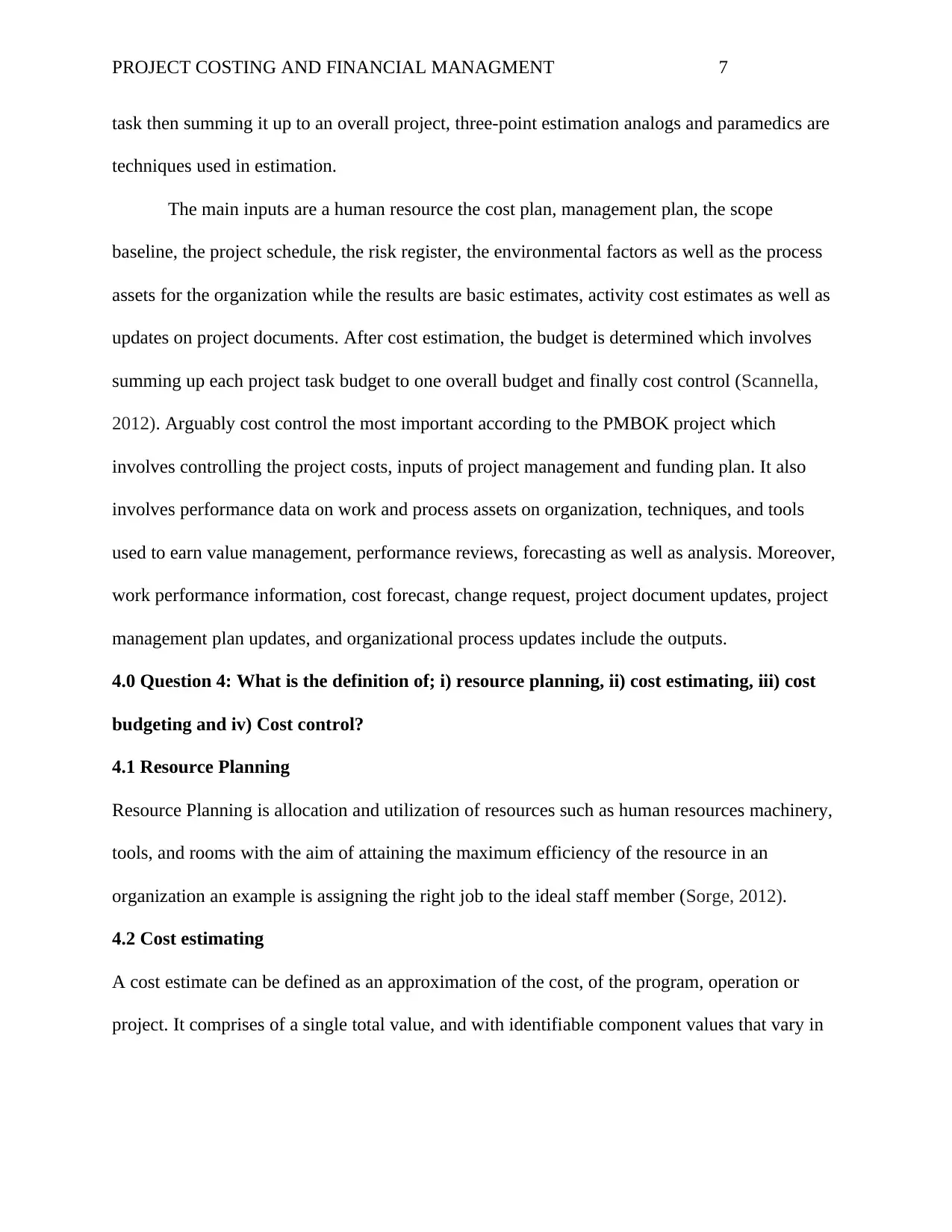
PROJECT COSTING AND FINANCIAL MANAGMENT 7
task then summing it up to an overall project, three-point estimation analogs and paramedics are
techniques used in estimation.
The main inputs are a human resource the cost plan, management plan, the scope
baseline, the project schedule, the risk register, the environmental factors as well as the process
assets for the organization while the results are basic estimates, activity cost estimates as well as
updates on project documents. After cost estimation, the budget is determined which involves
summing up each project task budget to one overall budget and finally cost control (Scannella,
2012). Arguably cost control the most important according to the PMBOK project which
involves controlling the project costs, inputs of project management and funding plan. It also
involves performance data on work and process assets on organization, techniques, and tools
used to earn value management, performance reviews, forecasting as well as analysis. Moreover,
work performance information, cost forecast, change request, project document updates, project
management plan updates, and organizational process updates include the outputs.
4.0 Question 4: What is the definition of; i) resource planning, ii) cost estimating, iii) cost
budgeting and iv) Cost control?
4.1 Resource Planning
Resource Planning is allocation and utilization of resources such as human resources machinery,
tools, and rooms with the aim of attaining the maximum efficiency of the resource in an
organization an example is assigning the right job to the ideal staff member (Sorge, 2012).
4.2 Cost estimating
A cost estimate can be defined as an approximation of the cost, of the program, operation or
project. It comprises of a single total value, and with identifiable component values that vary in
task then summing it up to an overall project, three-point estimation analogs and paramedics are
techniques used in estimation.
The main inputs are a human resource the cost plan, management plan, the scope
baseline, the project schedule, the risk register, the environmental factors as well as the process
assets for the organization while the results are basic estimates, activity cost estimates as well as
updates on project documents. After cost estimation, the budget is determined which involves
summing up each project task budget to one overall budget and finally cost control (Scannella,
2012). Arguably cost control the most important according to the PMBOK project which
involves controlling the project costs, inputs of project management and funding plan. It also
involves performance data on work and process assets on organization, techniques, and tools
used to earn value management, performance reviews, forecasting as well as analysis. Moreover,
work performance information, cost forecast, change request, project document updates, project
management plan updates, and organizational process updates include the outputs.
4.0 Question 4: What is the definition of; i) resource planning, ii) cost estimating, iii) cost
budgeting and iv) Cost control?
4.1 Resource Planning
Resource Planning is allocation and utilization of resources such as human resources machinery,
tools, and rooms with the aim of attaining the maximum efficiency of the resource in an
organization an example is assigning the right job to the ideal staff member (Sorge, 2012).
4.2 Cost estimating
A cost estimate can be defined as an approximation of the cost, of the program, operation or
project. It comprises of a single total value, and with identifiable component values that vary in
Paraphrase This Document
Need a fresh take? Get an instant paraphrase of this document with our AI Paraphraser
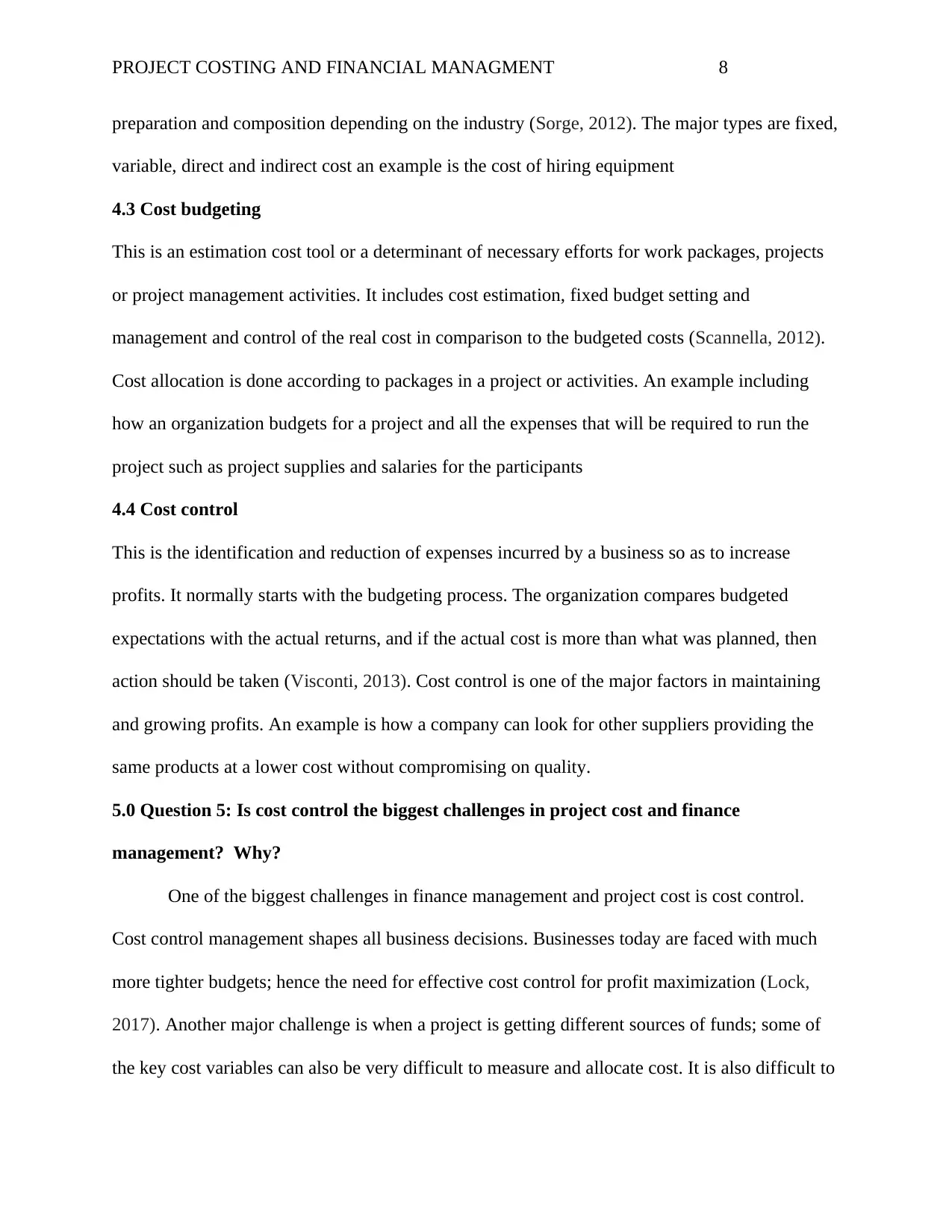
PROJECT COSTING AND FINANCIAL MANAGMENT 8
preparation and composition depending on the industry (Sorge, 2012). The major types are fixed,
variable, direct and indirect cost an example is the cost of hiring equipment
4.3 Cost budgeting
This is an estimation cost tool or a determinant of necessary efforts for work packages, projects
or project management activities. It includes cost estimation, fixed budget setting and
management and control of the real cost in comparison to the budgeted costs (Scannella, 2012).
Cost allocation is done according to packages in a project or activities. An example including
how an organization budgets for a project and all the expenses that will be required to run the
project such as project supplies and salaries for the participants
4.4 Cost control
This is the identification and reduction of expenses incurred by a business so as to increase
profits. It normally starts with the budgeting process. The organization compares budgeted
expectations with the actual returns, and if the actual cost is more than what was planned, then
action should be taken (Visconti, 2013). Cost control is one of the major factors in maintaining
and growing profits. An example is how a company can look for other suppliers providing the
same products at a lower cost without compromising on quality.
5.0 Question 5: Is cost control the biggest challenges in project cost and finance
management? Why?
One of the biggest challenges in finance management and project cost is cost control.
Cost control management shapes all business decisions. Businesses today are faced with much
more tighter budgets; hence the need for effective cost control for profit maximization (Lock,
2017). Another major challenge is when a project is getting different sources of funds; some of
the key cost variables can also be very difficult to measure and allocate cost. It is also difficult to
preparation and composition depending on the industry (Sorge, 2012). The major types are fixed,
variable, direct and indirect cost an example is the cost of hiring equipment
4.3 Cost budgeting
This is an estimation cost tool or a determinant of necessary efforts for work packages, projects
or project management activities. It includes cost estimation, fixed budget setting and
management and control of the real cost in comparison to the budgeted costs (Scannella, 2012).
Cost allocation is done according to packages in a project or activities. An example including
how an organization budgets for a project and all the expenses that will be required to run the
project such as project supplies and salaries for the participants
4.4 Cost control
This is the identification and reduction of expenses incurred by a business so as to increase
profits. It normally starts with the budgeting process. The organization compares budgeted
expectations with the actual returns, and if the actual cost is more than what was planned, then
action should be taken (Visconti, 2013). Cost control is one of the major factors in maintaining
and growing profits. An example is how a company can look for other suppliers providing the
same products at a lower cost without compromising on quality.
5.0 Question 5: Is cost control the biggest challenges in project cost and finance
management? Why?
One of the biggest challenges in finance management and project cost is cost control.
Cost control management shapes all business decisions. Businesses today are faced with much
more tighter budgets; hence the need for effective cost control for profit maximization (Lock,
2017). Another major challenge is when a project is getting different sources of funds; some of
the key cost variables can also be very difficult to measure and allocate cost. It is also difficult to
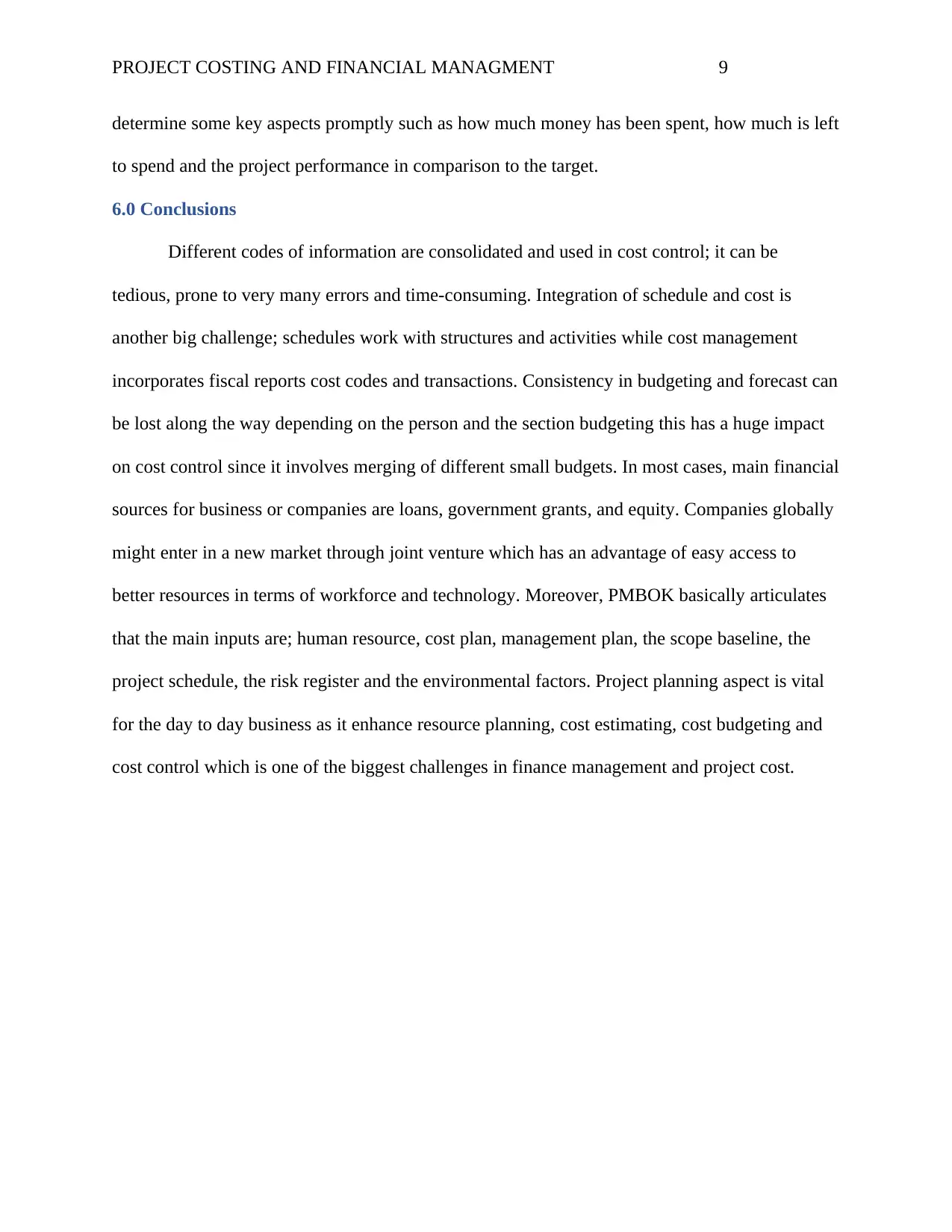
PROJECT COSTING AND FINANCIAL MANAGMENT 9
determine some key aspects promptly such as how much money has been spent, how much is left
to spend and the project performance in comparison to the target.
6.0 Conclusions
Different codes of information are consolidated and used in cost control; it can be
tedious, prone to very many errors and time-consuming. Integration of schedule and cost is
another big challenge; schedules work with structures and activities while cost management
incorporates fiscal reports cost codes and transactions. Consistency in budgeting and forecast can
be lost along the way depending on the person and the section budgeting this has a huge impact
on cost control since it involves merging of different small budgets. In most cases, main financial
sources for business or companies are loans, government grants, and equity. Companies globally
might enter in a new market through joint venture which has an advantage of easy access to
better resources in terms of workforce and technology. Moreover, PMBOK basically articulates
that the main inputs are; human resource, cost plan, management plan, the scope baseline, the
project schedule, the risk register and the environmental factors. Project planning aspect is vital
for the day to day business as it enhance resource planning, cost estimating, cost budgeting and
cost control which is one of the biggest challenges in finance management and project cost.
determine some key aspects promptly such as how much money has been spent, how much is left
to spend and the project performance in comparison to the target.
6.0 Conclusions
Different codes of information are consolidated and used in cost control; it can be
tedious, prone to very many errors and time-consuming. Integration of schedule and cost is
another big challenge; schedules work with structures and activities while cost management
incorporates fiscal reports cost codes and transactions. Consistency in budgeting and forecast can
be lost along the way depending on the person and the section budgeting this has a huge impact
on cost control since it involves merging of different small budgets. In most cases, main financial
sources for business or companies are loans, government grants, and equity. Companies globally
might enter in a new market through joint venture which has an advantage of easy access to
better resources in terms of workforce and technology. Moreover, PMBOK basically articulates
that the main inputs are; human resource, cost plan, management plan, the scope baseline, the
project schedule, the risk register and the environmental factors. Project planning aspect is vital
for the day to day business as it enhance resource planning, cost estimating, cost budgeting and
cost control which is one of the biggest challenges in finance management and project cost.
⊘ This is a preview!⊘
Do you want full access?
Subscribe today to unlock all pages.

Trusted by 1+ million students worldwide
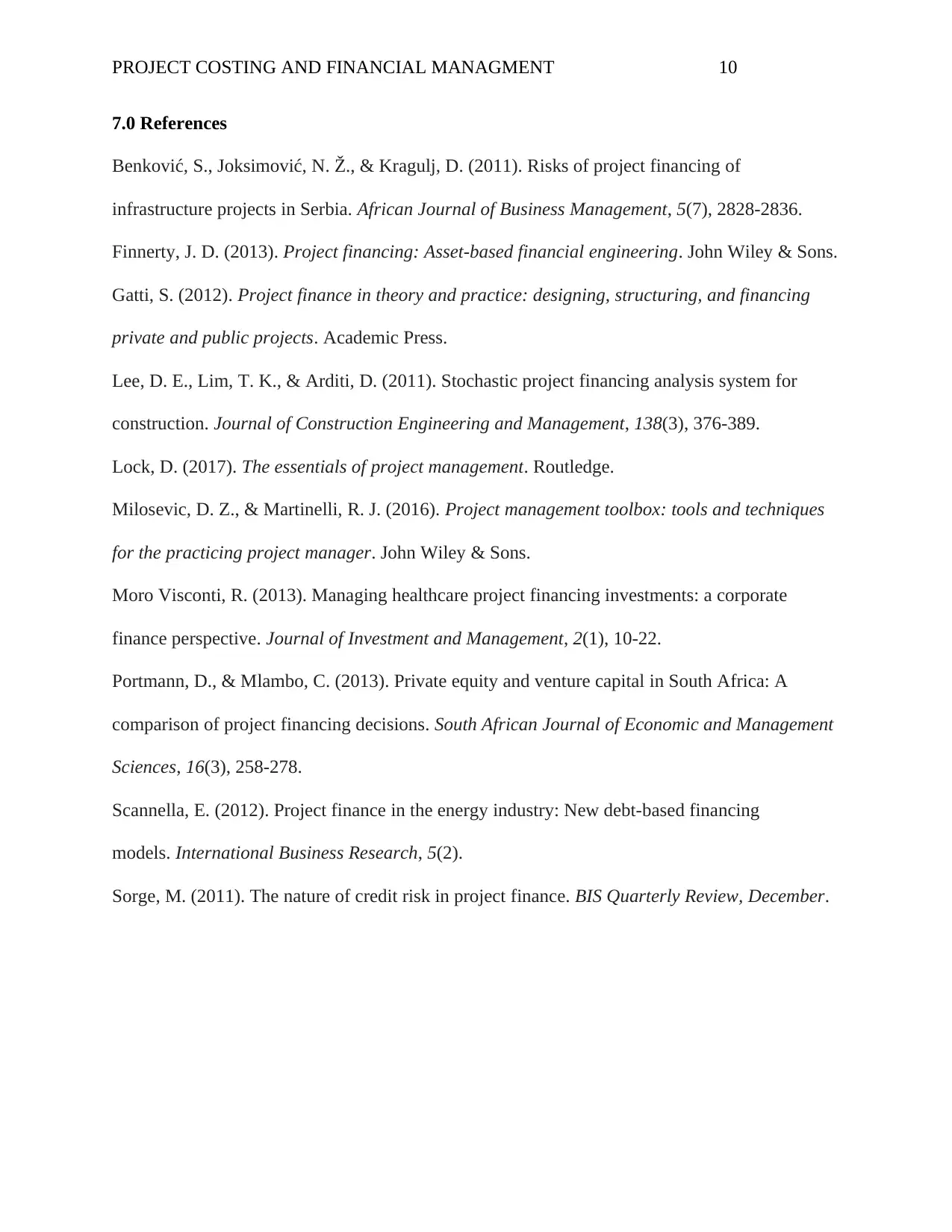
PROJECT COSTING AND FINANCIAL MANAGMENT 10
7.0 References
Benković, S., Joksimović, N. Ž., & Kragulj, D. (2011). Risks of project financing of
infrastructure projects in Serbia. African Journal of Business Management, 5(7), 2828-2836.
Finnerty, J. D. (2013). Project financing: Asset-based financial engineering. John Wiley & Sons.
Gatti, S. (2012). Project finance in theory and practice: designing, structuring, and financing
private and public projects. Academic Press.
Lee, D. E., Lim, T. K., & Arditi, D. (2011). Stochastic project financing analysis system for
construction. Journal of Construction Engineering and Management, 138(3), 376-389.
Lock, D. (2017). The essentials of project management. Routledge.
Milosevic, D. Z., & Martinelli, R. J. (2016). Project management toolbox: tools and techniques
for the practicing project manager. John Wiley & Sons.
Moro Visconti, R. (2013). Managing healthcare project financing investments: a corporate
finance perspective. Journal of Investment and Management, 2(1), 10-22.
Portmann, D., & Mlambo, C. (2013). Private equity and venture capital in South Africa: A
comparison of project financing decisions. South African Journal of Economic and Management
Sciences, 16(3), 258-278.
Scannella, E. (2012). Project finance in the energy industry: New debt-based financing
models. International Business Research, 5(2).
Sorge, M. (2011). The nature of credit risk in project finance. BIS Quarterly Review, December.
7.0 References
Benković, S., Joksimović, N. Ž., & Kragulj, D. (2011). Risks of project financing of
infrastructure projects in Serbia. African Journal of Business Management, 5(7), 2828-2836.
Finnerty, J. D. (2013). Project financing: Asset-based financial engineering. John Wiley & Sons.
Gatti, S. (2012). Project finance in theory and practice: designing, structuring, and financing
private and public projects. Academic Press.
Lee, D. E., Lim, T. K., & Arditi, D. (2011). Stochastic project financing analysis system for
construction. Journal of Construction Engineering and Management, 138(3), 376-389.
Lock, D. (2017). The essentials of project management. Routledge.
Milosevic, D. Z., & Martinelli, R. J. (2016). Project management toolbox: tools and techniques
for the practicing project manager. John Wiley & Sons.
Moro Visconti, R. (2013). Managing healthcare project financing investments: a corporate
finance perspective. Journal of Investment and Management, 2(1), 10-22.
Portmann, D., & Mlambo, C. (2013). Private equity and venture capital in South Africa: A
comparison of project financing decisions. South African Journal of Economic and Management
Sciences, 16(3), 258-278.
Scannella, E. (2012). Project finance in the energy industry: New debt-based financing
models. International Business Research, 5(2).
Sorge, M. (2011). The nature of credit risk in project finance. BIS Quarterly Review, December.
1 out of 10
Related Documents
Your All-in-One AI-Powered Toolkit for Academic Success.
+13062052269
info@desklib.com
Available 24*7 on WhatsApp / Email
![[object Object]](/_next/static/media/star-bottom.7253800d.svg)
Unlock your academic potential
Copyright © 2020–2025 A2Z Services. All Rights Reserved. Developed and managed by ZUCOL.





